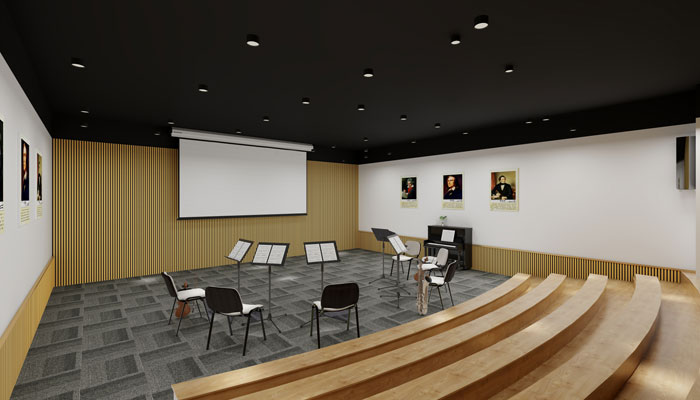In auditoriums used for performances and shows, great sound clarity is very important. To play the original sound as the performer intended, the acoustics must be very clear. However, the problem with many venues is the poor acoustics of the premises. This can lead to sound distortion and detract from the audience’s experience.
Table of Contents
Toggle
How Do Acoustic Panels Work in Auditoriums?
Auditoriums need high-quality sound to keep the audience interested and satisfied. Rooms with poor acoustics can suffer from sound malfunctions that can ruin the audience’s listening experience. Below is information about acoustic wall panels for auditoriums.
| Section | Key Takeaways |
|---|---|
| Understanding Auditorium Acoustic | The way an auditorium is designed can affect sound transmission. For example, non-parallel surfaces can affect the acoustics in a room. Good acoustic treatment is very important. This is because poor acoustics affect the clarity of sound and music. |
| Improving Auditorium Sound Quality | Balanced sound propagation is important to improve the listening experience. Much of the sound absorption and sound quality improvement is achieved through acoustic panels or sound-absorbing materials. |
| Types of Auditorium Acoustic Products | Polyester fiberboards, fabric panels, ceiling rafts, and partitions can help control echoes and improve the appearance of a room. Customization options allow acoustical solutions to meet the needs of auditorium design. |
| Practical Steps for Auditorium Soundproofing | Acoustic treatments can be properly applied through a four-step process of evaluation, planning, selection and installation. For sound-absorbing materials to be effective, they must be evenly distributed and skillfully placed. |
| Achieving Optimal Sound Clarity | Acoustic treatments can be properly applied through a four-step process of evaluation, planning, selection, and installation. For sound-absorbing materials to be effective, they must be evenly distributed and skillfully placed. |
| Wrap Up | Acoustic panels improve the sound quality of an auditorium and make performances run more smoothly. You can read case studies and take courses on noise control programs. This can help you learn more about how to do acoustic treatment effectively. |
Understanding Auditorium Acoustics
Sound quality is important for more than just enjoying clear tones and music. Equally important is the ability of sound to engage people, evoke emotion, and create an immersive experience for the audience. Quality sound connects the stage to the audience and ensures that information and emotions are delivered clearly and without compromise. This is true for both the subtleties in musical performance and the clarity of a speaker’s words.
However, due to the way auditoriums are built and the acoustics, it may not be possible to achieve high-quality sound. Poor room acoustics create echoes, reverberation, and background noise. It can block out the original sound and make the entire listening experience much worse for the audience.
Sound waves moving around the room are one of the biggest problems. Without proper acoustic treatment, sound can reflect off hard objects and create echoes or reverberation. And echo and reverberation can make music and speech less clear.
Similarly, auditoriums without adequate sound-absorbing materials can let in background noise, which can make high-quality music much less enjoyable. These problems with sound don’t just make it harder for the audience to enjoy the performance. They also make it harder for artists who need clear, balanced sound to perform.
Addressing these issues requires a holistic approach to auditorium design and sound control. Focus on the use of sound-absorbing materials and acoustic panels to mitigate poor room acoustics. By prioritizing the acoustics of the space, you can make it a place that is bursting with great sound. Good sound quality ensures that every performance has the clarity and depth it deserves.

Improving Auditorium Sound Quality
The main goal of improving sound quality in an auditorium is to ensure that the sound is spread evenly throughout the area. This allows every audience member to hear with the same clarity and richness. This means carefully controlling the sound waves to avoid any dead spots or areas of reduced sound level.
Balanced sound distribution ensures that everyone in the audience can clearly hear the original sound. Whether it’s a speech, music, or other program. Finding this balance requires careful planning of the building layout and placement of sound-absorbing materials. Sometimes technical help is also needed. Such as a sound reinforcement system that can flexibly change the sound according to the room’s sound.
The Role of Sound-absorbing Materials
Sound-absorbing materials are needed if you want to get the best sound quality in your theater. These materials, such as acoustic panels, fabric panels, and other means of sound absorption, are very important to the sound absorption of a room. They work by collecting sound waves that would otherwise be reflected in the room. If the reflected sound waves are not treated, they can create echoes and reverberations. And echo and reverberation then affect the acoustics in the room.

Polyester fiber acoustic panels, in particular, are a great way to both control sound and decorate a room. Since polyester fiberboard can be altered to suit the style and sound needs of the auditorium. It is therefore a flexible option for both blocking noise and making the room look more aesthetically pleasing. By reducing background noise and reverberation, these sound-absorbing materials can greatly improve sound quality. This ensures that performances can be heard clearly.
Various Acoustic Panels for Auditoriums
Choosing the right acoustic material is important to address the different sound issues in each auditorium. This section will discuss the different options, focusing on polyester fiberboard, ceiling rafts, and acoustic panels. Let’s find out how they can improve sound quality.
Polyester Fiber Acoustic Panels
Polyester fiberboard is an important part of auditorium acoustics. It absorbs noise effectively and decorates the auditorium in a better way. There are many options for these acoustic panels to match or go with the interior design of the auditorium. You can change many aspects of the polyester fiber panels such as size and color. This way the most suitable acoustic panels are chosen to handle the sound.

The main function of acoustic panels is to absorb sound waves and reduce reverberation and echo. This results in clearer and better-quality sound. Because polyester fiber panels are so flexible, architects and sound engineers love them. This is because they can be mounted on walls or ceilings in different ways to solve different sound problems.
Ceiling Rafts and Acoustic Ceilings
Ceiling rafts are hung horizontally from the ceiling and work best in spacious, open rooms. This is because in such rooms it is important to prevent sound from reflecting off the ceiling to maintain the clarity of the room. They can come in different sizes and shapes, which have an effect on both sound and sight lines in the theater. You can also use ceiling baffles that are suspended vertically to make the effect seem stronger.
Practical Steps for Acoustic Treatment of Auditoriums
Finding and fixing sound leaks and poor acoustics in your auditorium is an important part of improving sound quality. This section describes the practical steps for installing acoustic panels to ensure that acoustic wall panels cover all areas and are installed quickly and correctly so that the sound is as clear as possible.

When installing acoustic panels in an auditorium, there are four steps that can be used to ensure that all aspects of acoustics are handled correctly:
- Assessment. The first step is to scrutinize the auditorium’s current acoustics to identify problem spots where excessive reflections or echoes cause poor sound quality.
- Planning. Once the assessment is complete, a thorough plan is created that lists the type and amount of acoustical materials needed. The plan will take into account the size and shape of the auditorium and the unique acoustical problems that have been identified.
- Selection. Select appropriate sound-absorbing materials such as polyester fiberboard, ceiling rafts, and baffles. Decisions are based on their ability to absorb sound waves and their appearance in the room.
- Installation. The final step is to carefully install the selected acoustic panels in place. The location of the installation is very important and special attention should be paid to the areas that have the greatest impact on sound quality. For example, walls directly in front of the audience or areas with high echoes.
It is important to note that auditoriums vary greatly from one auditorium to another. Therefore it is essential to carry out an on-site study of the auditorium in order to obtain the best sound-absorbing effect.

Importance of Proper Coverage for Effective Acoustic Treatment
For acoustic treatments to be effective, it is important to ensure that the right amount of sound-absorbing material is used. This does not mean that every surface should be covered. Instead, it means focusing on the areas where sound reflections and echoes are greatest. The goal is to find the right balance between sound absorption and reflection. This keeps the original sound clear and good without making the room sound too flat.
Often, acoustic panels, ceiling clouds, and other acoustic treatments are installed in the walls for optimal results. Sound waves are controlled and background noise is reduced by strategically placed acoustic materials. The coverage of the acoustic material is determined by the specific acoustic needs of the auditorium. Changes can then be made based on the results of the initial placement.
Acoustic Panels Placement and Installation Method Guidelines
For the acoustic solution to be as effective as possible, the acoustic panels must be placed correctly. Acoustic wall panels should be laid evenly throughout the theater. Particular attention should be paid to hard surfaces opposite the stage or speakers or other areas where sound waves tend to reflect. Ceilings and corners are also important, as they often allow sound to build up and reverberate.

Different types of acoustic panels need to be mounted on different surfaces in different ways. For example, fabric can be secured with clips, glue, or a framing system. This is easy to remove or alter as needed. It is important to install the panels according to the manufacturer’s instructions. This will ensure that they work as intended and improve sound quality and clarity as desired.
Recommended Amount of Acoustic Panel Coverage
For the clearest, most perfect sound, the surface areas of the auditorium should be covered with a certain amount of acoustic panels. a good rule of thumb is that between 20% and 30% of the walls and ceiling should be covered with acoustic material. This coverage helps to process sound waves well, reducing background noise and reverberation without making the room too quiet.
The best coverage of acoustic panels ensures that sound waves are absorbed when necessary. It also allows for some sound reflection so that the original sound remains clear and vivid. The goal is to create a better-sounding space where quality sound can be heard clearly.

Summary
In conclusion, understanding the basics of acoustic panels is essential to creating the best possible sound conditions in an auditorium. Installing acoustic wall panels in the right places can minimize unwanted noise and improve the overall sound quality.
From choosing the right type of acoustic panels to considering factors such as location, size, and material. Each aspect plays a vital role in achieving acoustic excellence. Through careful planning and implementation, auditoriums can provide audiences with an immersive and enjoyable audio experience. Therefore investment in acoustic panels is an important part of any auditorium design.






